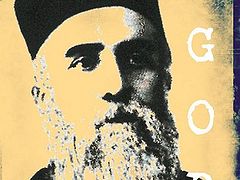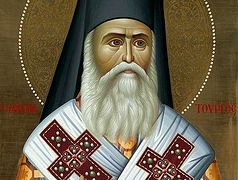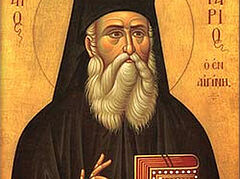Archpriest Vitaly Koplachenko tells about how the Optina Elders blessed his trip to Mt. Athos and what miraculous events happened during his trip.
Archpriest Vitaly Koplachenko is the rector of the Church of the Exaltation of the Holy Cross in the city of Khvalinsk, the dean of the Khvalinsk Deanery of the Saratov Diocese, and director of the Orthodox School of the Holy Martyr Count Alexander Medem. Fr. Vitaly is also an historian with a university education, and the father of seven children, from three months to seventeen years old.
—The providence of God acts in the life of every man, but sometimes it is hidden, and sometimes it clearly reveals itself in some signs, significant meetings, or in words we hear. Dear Fr. Vitaly, could you share with us, have there been any such signs or clear manifestations of the providence of God in your life?
Father’s answer turned into an amazing testimony about the miraculous providence of God in the life of man and a real story:
 Archpriest Vitaly with his family
Archpriest Vitaly with his family
The providence of God is God’s care for man
The providence of God is present in the life of every man, but it perhaps works especially clearly in the life of a priest. After all, what is the providence of God? It’s the care of God for man—total care, both for man’s daily needs, and most importantly—for the salvation of his soul; care that the human heart is filled with love more and more.
How a photograph called me to the road
 Archpriest Vitaly I experienced the effect of God’s manifest providence when I first visited Mt. Athos. This is what happened. Once, in 2002, I went to Optina Monastery, where a monk approached me absolutely unexpectedly, silently handed me a photo, and left. It was a photo of some beautiful reliquaries. They were photographed from above, and only the table, reliquaries, and floor were visible. There was no inscription. Where was it, what was it? Nevertheless, the photograph strangely stirred my soul, as if calling me. I started asking the Optina fathers where to find these relics, and they told me it seemed like Greece, like Mt. Athos. After that, I couldn’t shake the thought of going to the portion of the Mother of God.
Archpriest Vitaly I experienced the effect of God’s manifest providence when I first visited Mt. Athos. This is what happened. Once, in 2002, I went to Optina Monastery, where a monk approached me absolutely unexpectedly, silently handed me a photo, and left. It was a photo of some beautiful reliquaries. They were photographed from above, and only the table, reliquaries, and floor were visible. There was no inscription. Where was it, what was it? Nevertheless, the photograph strangely stirred my soul, as if calling me. I started asking the Optina fathers where to find these relics, and they told me it seemed like Greece, like Mt. Athos. After that, I couldn’t shake the thought of going to the portion of the Mother of God.
The thought of going to Mt. Athos
In 2002 I had just begun my pastoral ministry and had served for a year in the Church of the “She Who is Quick to Hear” Icon of the Mother of God in Saratov. In the spring of 2003, Bishop Longin (Korchagin), now the Metropolitan of Saratov and Volsk, came to our diocese. When I first met him, I asked him a single question:
“Vladyka, the thought of going to Mt. Athos won’t leave me…”
The elders teach us to check every thought with time and prayer, and apparently that’s why Vladyka answered me: “Come see me about this in a month.”
Exactly a month later, I was again with Vladyka Longin, and I confessed to him that the thought wouldn’t leave me. He blessed me to prepare my documents for the trip, as any clergyman can go to Mt. Athos only by invitation. Finally this letter came, and Vladyka blessed me for a three-week pilgrimage. After Pascha, I headed for the Holy Mountain. I had that same photograph in my pocket.
A week like a day
The first monastery I visited was the Russian St. Panteleimon’s Monastery. They settled me in a cell; I zealously went to all the services. I prayed at the head of St. Silouan the Athonite and felt strong grace. I didn’t want to go anywhere else, to any other Athonite monastery. Tears of affection and gratitude flowed by themselves, and my first week on Mt. Athos flew by like one day.
An unexpected meeting
Still, I planned to see other monasteries, and I absolutely had to find the place that was depicted on the carefully preserved photograph. I wanted to go to the Serbian Hilandar Monastery. However, they discouraged me to go there, because there had been a huge fire during Great Lent and they weren’t receiving any pilgrims yet.
But I really wanted to visit the Serbian monastery, and I decided to go. They received me there, invited me to a meal in the kitchen (it seems it was the guest house that burned). There was an elderly monk next to me behind the table who spoke Russian very well. He started a conversation with me and showed me the herb that Athonite ascetics used to eat. He joked and was very simple in conversation. I was still a very young priest then and also relaxed and also spoke with this monk simply, and also joked—until I noticed the skufia lying next to him. There was a cross on the skufia, which means I was speaking with a bishop. When he was distracted, I whispered to the cook monk: “Excuse me, is he a bishop?”
The cook nodded: “A bishop! A bishop!”
From me there followed a silent scene worthy, by all appearances, of the pen of Gogol.
 Bishop Athanasy (Evtich) When I went to the evening service, I stood quietly in a stasidia and began to quietly pray. One of the brothers of the monastery came up to me and said, “The bishop is asking for you.”
Bishop Athanasy (Evtich) When I went to the evening service, I stood quietly in a stasidia and began to quietly pray. One of the brothers of the monastery came up to me and said, “The bishop is asking for you.”
With sinking heart, I went to see the Serbian bishop. He stood me in front of the Three-Handed Icon of the Mother of God and blessed me: “Sing to the Mother of God!”
I sang the troparions that I knew by heart, and Vladyka must have been praying, because I felt how my soul was filled with joy, with such spiritual exultation.
Then he blessed me to serve Liturgy the next day.
Thus I met one of the most well-known contemporary theologians—Bishop Athanasy (Evtich). Later, I more than once jokingly recalled that this theologian spoke with me about herbs that Athonite ascetics used to eat.
St. Nektarios
Then I visited other monasteries and finally found the one from my photo. I asked the fathers, “Whose relics are these?”
They listed many saints for me, the name of one whom sunk into my soul—St. Nektarios of Aegina. I didn’t know anything about him then.
At the next Athonite monastery I met a Greek monk named Paul. He spoke Russian well, knew the lives of our saints, and read the works of Sts. Ignatius Brianchaninov and Theophan the Recluse. Fr. Paul told me about his meetings with Elder Paisios the Athonite, about how the Elder often said, “Everyone should become a factory of good thoughts.
I really liked this imagery and immediately imagined a waste processing plant where they take a lot of unnecessary and unused stuff and turn it into something useful. By the way, these plants are very lucrative. If only our factories of good thought were as spiritually profitable!
I asked Fr. Paul about St. Nektarios of Aegina. He left for a few minutes, ran off, and returned with a small photograph of the saint and said, “He’s a great saint!”
And he added, “Like St. Seraphim of Sarov or St. John of Kronstadt is for you Russians, that’s how St. Nektarios of Aegina is for us.”
He handed me the photo and we said a warm goodbye. I went on, very clearly understanding that the providence of God was leading me on this journey.
Dochariou and a wonderful book
I really wanted to visit Dochariou Monastery, where they have the wonderworking “She Who is Quick to Hear” Icon, because, as I said, I served in Saratov in the church in honor of this icon. When I arrived at Dochariou, I met one of the men who was working there on obedience. He showed me the place of his obedience in the garden, then decided to give me tea, and invited me to his cell.
While he was preparing a simple meal, I looked over the books on his bookshelf. I came across the book, The Life of St. Nektarios of Aegina, by the Greek archimandrite Ambrose (Fontrie). I had a few days left on Mt. Athos and I asked my new acquaintance to read this book (in the end he gave it to me).
The St. Nektarios book was extraordinary—I found the answers to many questions that were bothering me, and the clear providence of God and His tender, paternal care were also clearly seen in it.
A new meeting
Then I was sailing back on the ferry to Ouranopolis, and one question occupied my mind: Should I spend the night in tiny Ouranopolis and then go to Thessaloniki to the airport, or immediately go to the large unknown city and while away the day there until my flight (I had only enough money for the road to Thessaloniki and a plane ticket)?
I closed my eyes, thinking about it. Suddenly an old monk was pushing me on the shoulder and introduced himself very cheerfully: “Hello, I’m Monk Raphael. I’m a Serb. Come with me and I’ll buy you lunch and a place for the night.”
We got off and went to Ouranopolis. He took me to a café, got some food, and said, “Help yourself! Then we’ll have to wait for my friend Soterius—he’s going to take us to Thessaloniki.”
He sat next to me, watching me as I ate—his eyes shone with joy because the Lord had given him the opportunity to fulfill the commandment of love.
Fr. Raphael and Soterius
Soterius arrived, and we got in the car and headed for Thessaloniki. Monk Raphael said to me: “If you don’t mind, we’ll stop by the cemetery to pray at the grave of Soterius’ dead son.”
We arrived at the cemetery in Thessaloniki; it aroused very bright feelings in me: strict geometry, gravestones of white stone, clean, well-kempt, beautiful. We came to a marble tombstone. Next to it was a little alcove, covered with glass doors. Inside it were candles, incense, charcoal, and a prayer book.
Beside the headstone stood a marble book whose pages were as if fluttering in the wind. I asked Fr. Raphael to translate. Engraved on the page were the last words that Soterius’ son said to him: “Papa, don’t be upset! I’m going to Christ!”
We served a litiya, and I asked them to take me to the Monastery of St. John the Theologian in Souroti, to Elder Paisios the Athonite. We arrived, but the monastery gates were closed. Fr. Raphael said: “No worries. We’ll come again tomorrow before your plane!”
 Souroti, grave of St. Paisios the Athonite
Souroti, grave of St. Paisios the Athonite
The saints are near
Soterius took us to our accomodations, and we arrived a large, beautiful building. To the right was a church. I asked, “Who is this church named for?”
“For St. Nektarios of Aegina!”
 Tomb of St. Nektarios Soterius dropped us off and left, and Fr. Raphael and I went into the St. Nektarios hospital, where the holy elder would go for treatment. Fr. Raphael walked over to a nurse and said something to her joyfully. They laughed, looked at me kindly, and allowed me to go into the room. There were six beds in the room, all free. Fr. Raphael took his bag, threw it on one of the beds, and said, “That’s my bed!”
Tomb of St. Nektarios Soterius dropped us off and left, and Fr. Raphael and I went into the St. Nektarios hospital, where the holy elder would go for treatment. Fr. Raphael walked over to a nurse and said something to her joyfully. They laughed, looked at me kindly, and allowed me to go into the room. There were six beds in the room, all free. Fr. Raphael took his bag, threw it on one of the beds, and said, “That’s my bed!”
I followed the rules of the game, threw my travel bag on the second bed, and repeated in the same tone, “And this is my bed!”
Then I saw that at the head of each bed were small round icons. I looked: My bed had an icon of St. Nektarios. I figured it was probably the same icon on all the beds, but I still checked. Others bed had other icons. The saint was as if standing with me, taking care of me.
The next day, Soterius again took me to Souroti, but for some reason the monastery gates were closed again. My companion said, “Don’t worry! You’ll come here again!”
And indeed, in 2009, I was lucky enough to visit the Holy Mountain and the grave of Elder Paisios in Souroti again. I also went to Holy Trinity Monastery on the island of Aegina—to St. Nektarios of Aegina. At that point I already knew that the Holy Hierarch’s memory is celebrated on the day of the memory of the “She Who is Quick to Hear” Icon of the Mother of God—and I was serving in a church in honor of this icon.
 Venerable Elders of Optina I venerated the relics of St. Nektarios on October 24, which his also a noteworthy day—the feast of the Venerable Optina Elders, who once blessed me for my amazing and wondrous pilgrimage—after all, everything started with the photograph I was given at Optina Monastery.
Venerable Elders of Optina I venerated the relics of St. Nektarios on October 24, which his also a noteworthy day—the feast of the Venerable Optina Elders, who once blessed me for my amazing and wondrous pilgrimage—after all, everything started with the photograph I was given at Optina Monastery.
There were many coincidences and “non-accidental accidents” on my trip; after all—coincidences are the language with which God speaks to us. I was clearly shown how the Lord loves us and takes care of us, and His Most Pure Mother and the saints of God with Him, and how the providence of God leads us through life.
A small addition to the story: After our conversation, Fr. Vitaly called me and said that upon his return to Optina, he heard the brothers singing the famous song “Agni Parthene” (“O Pure Virgin”), which St. Nektarios of Aegina wrote for the Most Holy Theotokos.








